PREVIOUS
SDG Goal wise programs of India – Part 04
SDG Goal wise programs of India – Part 04
(இதன் தமிழ் வடிவத்திற்கு இங்கே சொடுக்கவும்)
Goal 2: Zero hunger
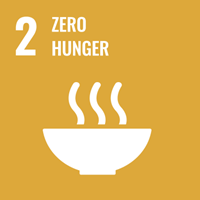
National Food Security Act (NFSA) 2013
Launched:
- 2013.
Ministry or Nodal Agency:
- Ministry of Consumer Affairs, Food, and Public Distribution.
Objectives of the NFSA 2013
- The National Food Security Act (NFSA) 2013 was introduced to ensure food security and improve the nutritional status of the population.
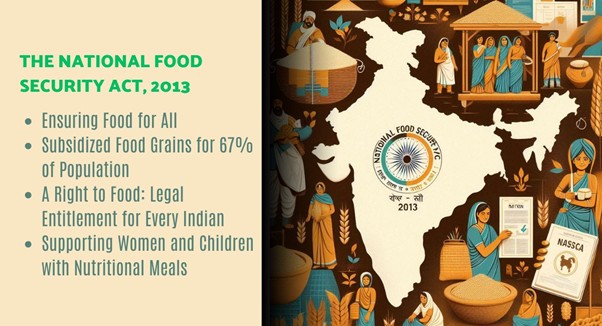
- The main objectives of the Act are:
- Food Security for All: To ensure access to adequate and affordable food to the entire population of India, focusing particularly on the most vulnerable sections.
- Affordable Food Grains: The act aims to provide essential food grains at subsidized prices to eligible beneficiaries.
- Reduction of Hunger & Malnutrition: A key aim of the NFSA is to combat hunger, malnutrition, and related diseases, by making food accessible to those in need.
- Targeting Vulnerable Groups: The Act focuses on identifying and targeting the households that need assistance the most, ensuring that no one is left behind.
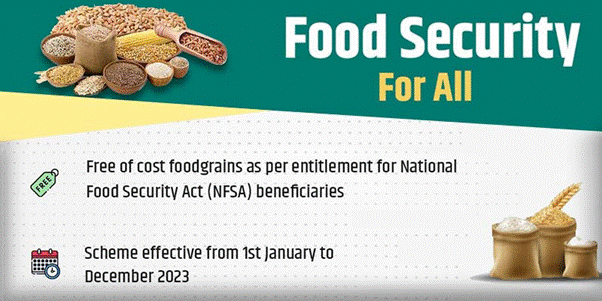
Beneficiaries under NFSA
- The NFSA provides food security to various vulnerable sections of society, including:
- Below Poverty Line (BPL) Families: Identified households under the BPL category.
- Antyodaya Anna Yojana (AAY) Households: The poorest of the poor, often including households headed by widows, disabled individuals, or those without able-bodied members.
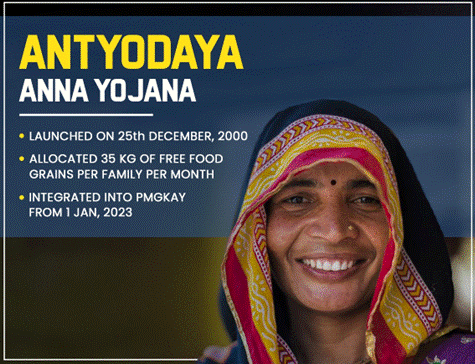
- Pregnant Women and Lactating Mothers: Special provisions for maternal nutrition.
- Children (6 months to 14 years): Nutritional support for children, including school meals under mid-day meal schemes.
Eligibility Criteria for Beneficiaries
- Priority Households (PHH): Households with no regular income, or those living in near-starvation conditions. These households are entitled to 5 kg of food grains per person per month.
- General Households: Households that are economically disadvantaged but not classified as "priority."
- These households are entitled to a lesser quantity of food grains.
Benefits Under NFSA
Subsidized Food Grains:
- Priority Households: 5 kg per person per month (coarse grains, wheat, rice).
- Antyodaya Anna Yojana (AAY) Households: 35 kg per month at subsidized rates.
- These food grains are distributed through the Public Distribution System (PDS).
Subsidized Pricing:
- The NFSA ensures that the food grains are available at highly subsidized prices:
- Rice at Rs. 3 per kg.
- Wheat at Rs. 2 per kg.
- Coarse grains at Rs. 1 per kg.
Nutritional Support for Women & Children:
- The Act also provides for supplementary nutrition through various schemes for pregnant women, lactating mothers, and children.
Grievance Redressal Mechanism:
- The Act mandates the establishment of grievance redressal mechanisms at the district and state levels to address issues related to the distribution of food grains.
Key Features of NFSA 2013
Coverage:
- Covers two-thirds of the population of India.
- 75% of the rural population and 50% of the urban population are entitled to subsidized food under NFSA.
Public Distribution System (PDS):
- PDS is the backbone of the NFSA, ensuring food grains are distributed to eligible households.
- State/UT-wise Coverage is determined based on the 2011-12 Household Consumption Expenditure survey by NSSO.
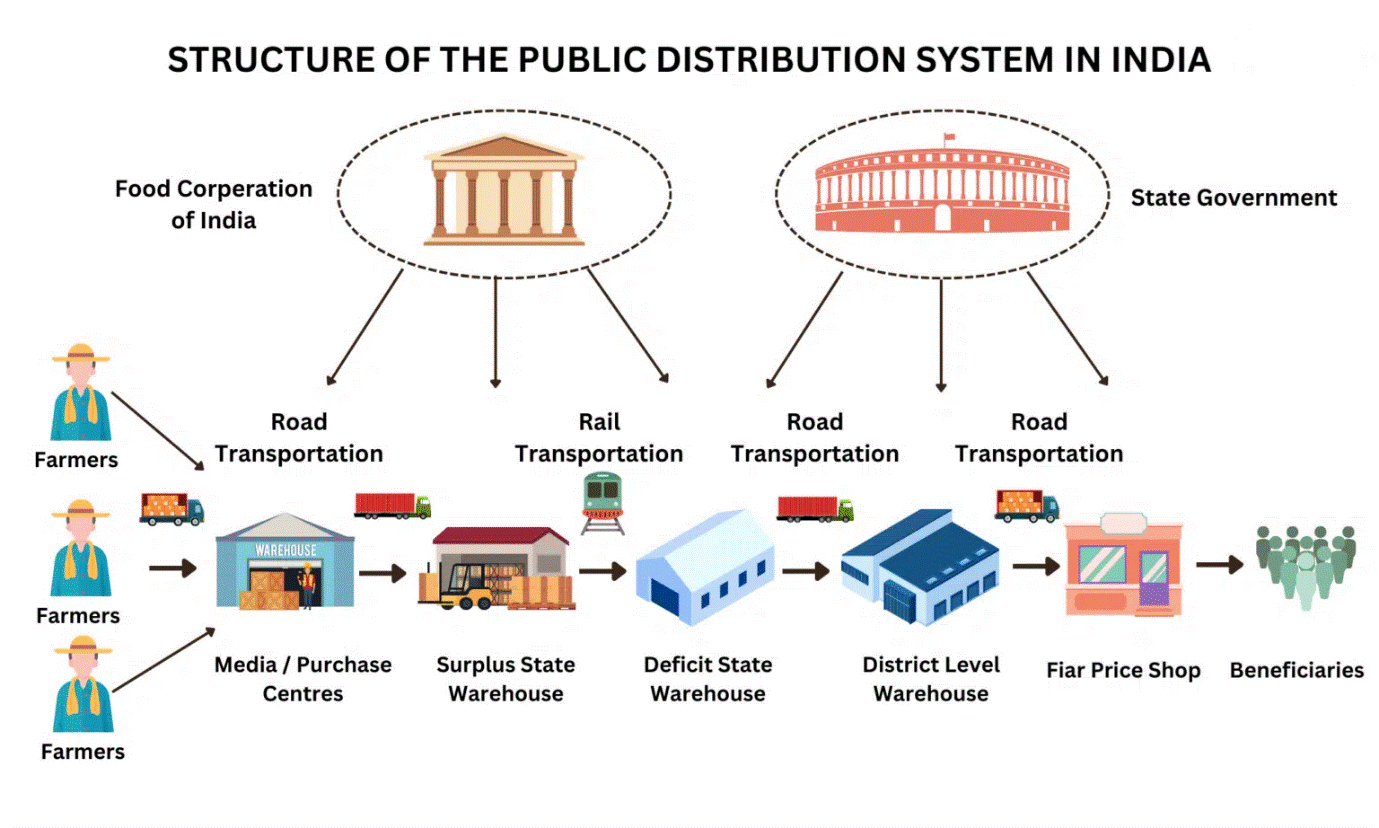
Central Issue Price:
- Coarse grains, wheat, and rice are provided at subsidized prices, which remain unchanged until June 2019.
Identification of Beneficiaries:
- The oldest woman in the household is considered the 'Head of Family' for ration card issuance under NFSA.
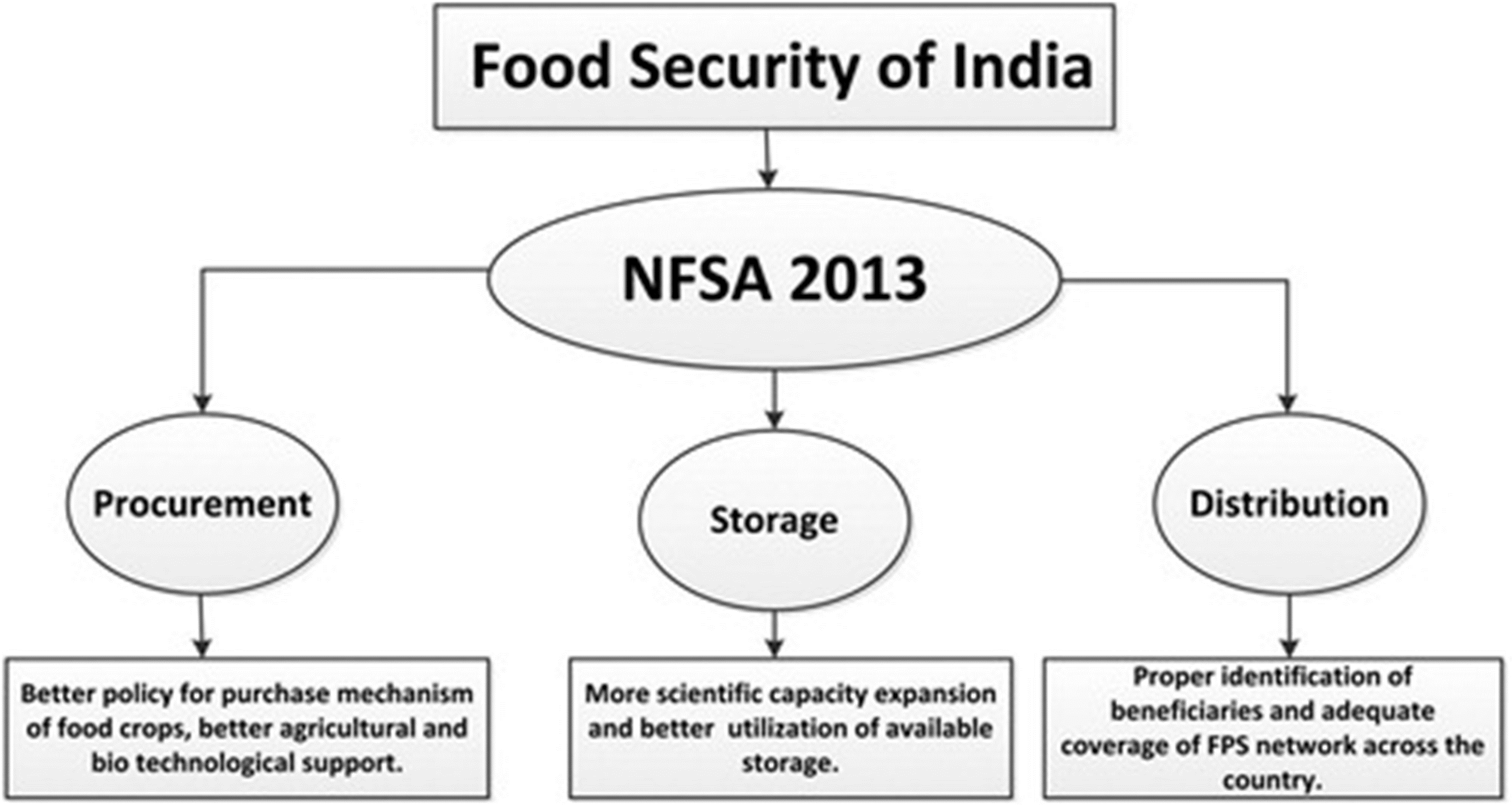
- States and UTs identify beneficiaries based on criteria provided by the central government, considering factors like income, occupation, and landholding.
Transparency:
- To improve transparency, NFSA mandates the publication of beneficiary lists and PDS records in the public domain.
- Social audits and regular monitoring are required for ensuring accountability.
Responsibilities Under NFSA
Central Government:
- Food Grain Allocation: Responsible for allocating food grains to states based on the identified beneficiaries.
- Funds for Transportation & Handling: The central government provides funds for food grain handling and intra-state transportation.
- Monitoring & Evaluation: Ensuring that the distribution process is transparent and that NFSA's objectives are met effectively.
- Ensuring Accountability: Strengthening mechanisms for grievance redressal and ensuring the transparency of PDS operations.
State Governments:
- Identification of Beneficiaries: States are responsible for identifying eligible households and issuing ration cards.
- Public Distribution System Management: Ensuring the smooth operation of PDS, including transportation, fair price shops, and food grain distribution.
- Grievance Redressal: Setting up grievance redressal mechanisms at the district and state levels to address issues faced by beneficiaries.
Local Authorities:
- Monitoring Fair Price Shops: Local authorities are responsible for ensuring fair price shops are functioning efficiently.
- Beneficiary Identification: Assisting in the identification of eligible beneficiaries and the issuance of ration cards.
Challenges and Criticism
Inefficiencies in PDS:
- Despite efforts, there are inefficiencies in the functioning of the Public Distribution System, including issues like leakages, corruption, and poor quality of food grains.
Beneficiary Identification:
- Inaccurate or inconsistent identification of beneficiaries has led to errors in coverage, where some in need are left out, and some ineligible households are included.
Financial Sustainability:
- The subsidized distribution of food grains puts a significant financial burden on the government, which may impact the overall sustainability of the scheme in the long run.
Infrastructure Issues:
- Some states face challenges in terms of infrastructure (such as poor transportation networks or inadequate storage facilities) for effectively implementing NFSA.
Regional Disparities:
- The level of implementation varies across states, leading to unequal access to food security among regions.
Pradhan Mantri Garib Kalyan Yojana (PMGKY)
Launched:
- 17th December 2016.
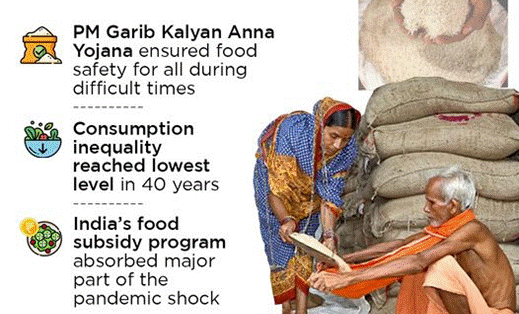
Ministry or Nodal Agency:
- Ministry of Finance.
Objectives of PMGKY
- The primary goals of the Pradhan Mantri Garib Kalyan Yojana are:
- Curb Black Money: The scheme provides a one-time opportunity for tax evaders to disclose their unaccounted wealth without facing any penalty or prosecution.
- The government charges a tax of 49.9% on the disclosed amount.
- Income Equality: The scheme aims to address income disparities and provide relief to economically vulnerable sections of society.
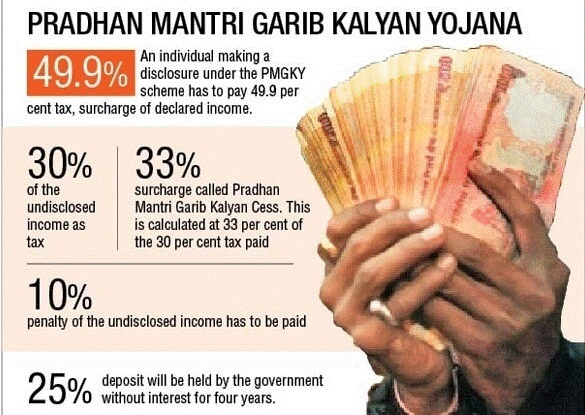
Eligibility Criteria
The key beneficiaries of PMGKY include:
- Below Poverty Line (BPL) Families: Families identified under the BPL category are eligible for various relief measures.
- Antyodaya Anna Yojana (AAY) Families: Families identified under AAY are also covered by the scheme.
- Priority Households (PHH): Identified by state governments/Union Territories based on specific criteria.
- Migrant Workers: PMGKY provides financial aid to migrant workers, especially during emergencies like the COVID-19 pandemic.
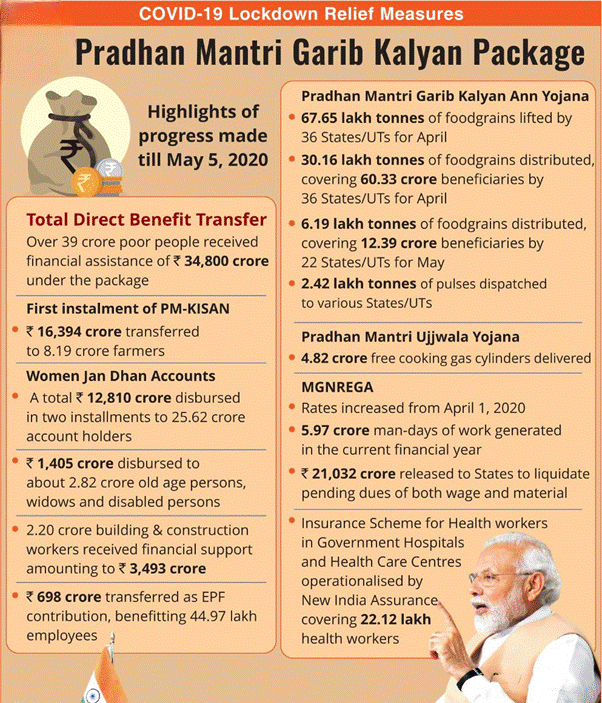
Key Benefits of PMGKY
Free Food Grains:
- The scheme provides 5 kg of free food grains per person per month to more than 80 crore people, with each family also receiving 1 kg of whole channa (chickpeas) per month.
Free LPG Cylinders:
- Under PMGKY, BPL families receive free LPG cylinders for a specified period, ensuring affordable cooking fuel.
Cash Transfers:
- Financial assistance is provided through cash transfers to women, elderly individuals, and other marginalized groups to ensure their economic stability.
Insurance Coverage for Frontline Workers:
- The scheme provides Rs 50 lakh insurance coverage to frontline workers, especially those engaged in COVID-19 relief efforts.
- This includes over 22 lakh health workers.
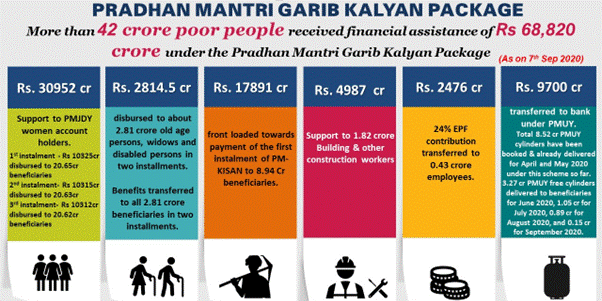
Employment Generation:
- PMGKY allocates Rs 50,000 crore for employment opportunities for people from vulnerable communities, focusing on creating jobs in rural areas.
Support for Tax Evasion Disclosure:
- Those who disclose their unaccounted wealth under the scheme are required to pay 50% of the undisclosed amount, along with investing 25% in the PMGKY scheme for four years.
- This helps avoid prosecution and penalties.
Additional Benefits
Social Security Measures:
- PMGKY aims to provide comprehensive social security by covering health insurance, pension schemes, and ensuring the well-being of marginalized communities.
Rural Economic Development:
- PMGKY supports rural employment schemes like the Mahatma Gandhi National Rural Employment Guarantee Act (MGNREGA), boosting the rural economy.
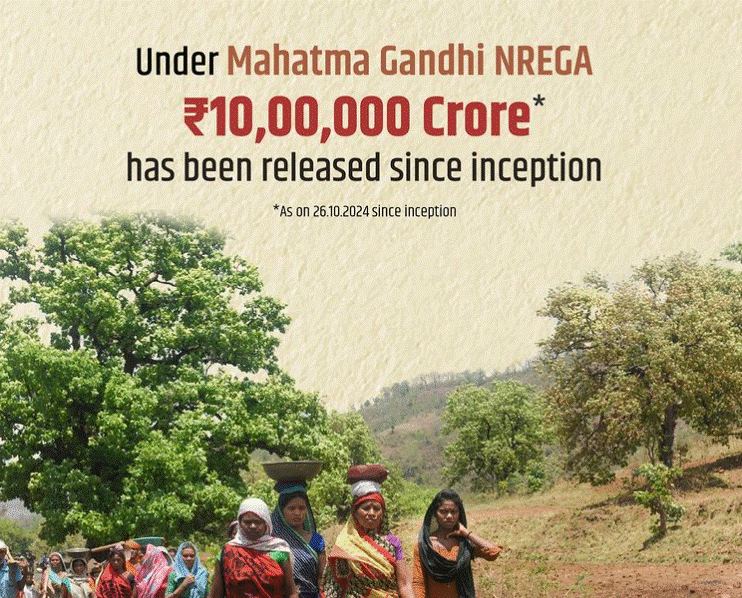
Health Benefits:
- Through schemes like Ayushman Bharat, the Yojana provides healthcare services to economically weaker sections.
Women Empowerment:
- PMGKY encourages financial inclusion for women by providing them with financial assistance, especially through LPG subsidies, improving their health and economic empowerment.
Challenges and Issues
Ineffective Implementation:
- Bureaucratic delays and inefficiencies hinder the smooth execution of the scheme, leading to delays in delivering benefits.
Insufficient Coverage:
- Many beneficiaries have been left out due to improper identification or documentation, despite the scheme's broad coverage goals.
Corruption and Leakages:
- There are reports of corruption at various levels of administration, resulting in resources not reaching the intended beneficiaries.
Dependence on Digital Infrastructure:
- The scheme's reliance on digital platforms can be problematic in areas with poor internet connectivity and low digital literacy, particularly in rural areas.
Ad hoc Measures:
- While the scheme offers immediate relief, it focuses more on short-term fixes rather than long-term poverty alleviation.
-------------------------------------


